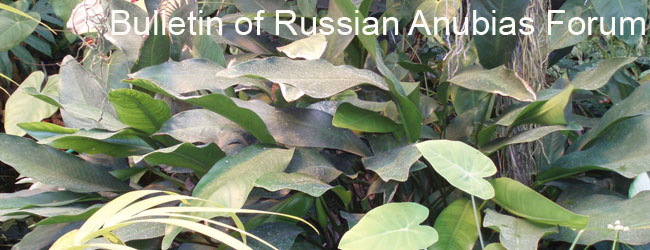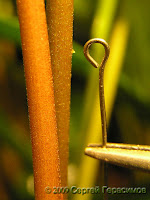
It’s well known that Anubias are riverside plants. But only some species can grow up well in aquarium; for example A. afzelii, A. barteri and some specimen of A. heterophylla. Though even these species grow up better in an emergent condition: they do it quickly, the leaves become larger, and more than that such plants blossom more often and so on. In the botanic garden’s greenhouses Anubias are grown up without water, meanwhile a damp peat or soil can be used as a ground. Such method also gives good results, the Anubias’ leaves grow very quickly. So as there is not so much water the leaves become firmer and harder than in aquarium. But this method is not suitable for small home greenhouses, because it’s difficult to fit out good ventilation in such a small volume and as the result the substratum can rot. That’s why it’s more suitable to keep Anubias in the emergent conditions, in such way it’s possible to avoid some undesirable anaerobic processes due to the water circulation and water changes. Besides there is an opportunity to proportion mineral fertilizers and distribute them properly. So the fancier of the aquatic fauna will like such method too, because in this way he can keep both, Anubias and aquatic animals, together.
An aquarium with a law water level can be used as a greenhouse. But it’s very difficult to maintain such aquariums. Theoretically we need some type of terrarium with side doors and leak proof bottom. In contrast to the “true” terrarium, there is no need in vent holes in such greenhouses for Anubias, as it would be very problematically to reach necessary air humidity (more than 90%). 
It’s better to use luminous tube lamps with a warm white light for lighting and these lamps should be fixed on the outside of the greenhouse in order to avoid leaf scorch. The water level 5-15 cm. is enough for the growth of the most Anubias’ species. The pump is to place in water for the circulation. It’s better to keep Anubias in small plastic flower pots. The usage of the pots simplifies the attendance of the plants and their replantation etc. I often use the packing from foodstuff, for example plastic yoghurt cups. It’s necessary to make small holes in the side of the cup for water cycle. The upper edge of the cup should be under the water and only for a little it can emerge upon the surface. Common pebbles or small clay pellets can be used as a substratum. Every fancier has his own opinion concerning the question which additives (clay, ash, peat etc.) should be added to the soil. I’ve checked several variants of such mixtures and I didn’t notice any striking differences from the pure pebbles. We should follow only one rule - add the additive no more as 1/3 from total amount of the substratum, otherwise there would be asescence (rotting) of the soil or further mortality of the plant. Very often the usage of the peat, in order to soften the water and decrease its’ hardness, is unreasonably: due to the regular water changes the effect is thus null. Mineral fertilizers should be added in water for Anubias’ full nutrition. It can be done in different ways. For example you can use some fertilizers for house plants. But sometimes they aren’t well balanced, so in this way they don’t supply the needs of Anubias. And very often there is an oversupply with one element and that can lead to the plant’s disease. This problem can be solved by regular water changes. The usage of alive hydrobionts is another way to supply Anubias with necessary nutrition. It can be as snails, so as different fishes. They will consume food and excrete the waste products, which are necessary for Anubias. More than that snails are very important for aquariums, they eat obsolescent leaves or the other part of the plants. Though this method has also some disadvantages. For example, if there are any aquatic organisms, so it’s impossible to use chemical substances in order to fight with pests and diseases. 
The temperature in greenhouse should be 22-26ºС. The direct sun should be avoided. Of course sometimes this natural lightening is useful for Anubias’ vital functions, but often it can lead to the air’s overheating, especially in summer. Anubias don’t like overheating (above 30 ºС) and vice versa overcooling (below 20 ºС). 
That’s all. Practically there are no difficulties in growing such plants at home greenhouse. It’s not as complicated as the violet’s cultivation ( Saintpaulia ionantha ) on the window sill.
The author of this note: Dmitry Loginov.
The author used info from the next Web pages: http://www.tropica.ru/modules/ss/item
.php?itemid=138 and http://www.tropica.ru/forum/index.php?showtopic=20547
Translated from Russian by Julia Niklyaeva and Alexander Grigorov
Photos: Dmitry Loginov and Valentina Romanova.
© Dmitry Loginov
© Alexander Grigorov


























